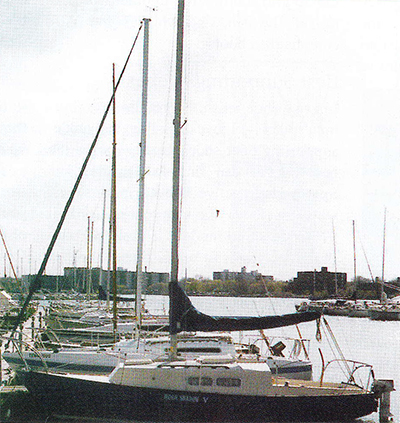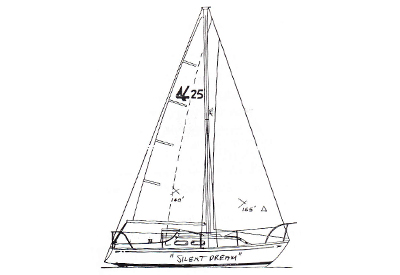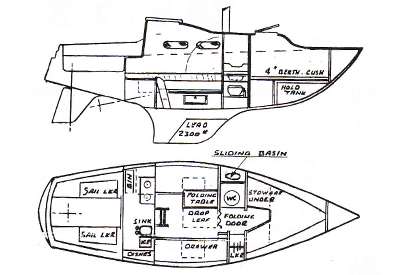Northern 25
 By Pat Sturgeon
By Pat Sturgeon
The first time I ever went aboard a Northern 25, was not a social call – I was actually providing an appraisal of the vessel – but I remember the event clearly. Up until that day, I had never had the chance to examine this well-known cruiser up close. From the dock it appeared to be a typical classic looking boat with a high coach house and long cockpit, but when l went below, the volume and clever layout of the interior astounded me. Most boats in this size range offering large interior space tend to look like a barn rather than a boat, but the Northern 25 was different. All the space a family of cruisers could hope for was tucked into just 25 feet and wrapped in an eye pleasing exterior. That particular vessel was well-appointed and in solid condition. Needless to say, my appraisal was quite positive and my admiration of the Northern 25 still holds today.
“Spacious interior” is a term that is commonly thrown about in appealing boat descriptions, so you are probably wondering just how much space we are talking about. Well, I had a client who travelled around Georgian Bay on board a Northern 25 for years with his wife and three kids. When the family started to look for a larger boat they were hard-pressed to find one in the 27-foot range that offered as much stowage and accommodation as their Northern 25. In fact, they had to get into the 30-foot range before there was an appreciable interior volume advantage.
You could say that the Northern 25 was designed and built by Dennis Fernice from Northern Yachts Ltd. in Ajax, Ont. Although the original design was actually a Rhodes 25, which Dennis totally remodelled in 1970 to provide for an expanded interior and improved performance.
The Northern 25 went through three design changes during its run. The MK I, which was the original boat modified from the Rhodes 25, had a lift-up companionway hatch, similar to a pop-top. This design held until 1973 when the MK II, which no longer had the hinged hatch feature, offered a slightly higher cabin top that provided for six feet of head room. The final design change, which resulted in the introduction of the MK 111 in 1978, increased the height of the cockpit coamings for drier sailing. The MK III was also a heavier boat at 5,200 pounds, up from the original weight of 4,800 lb., and this hindered its performance somewhat.
The Northern 25 has a dinette layout in the main saloon with the galley forward on the starboard side. This type of layout makes the eating and food preparation area very efficient. The dinette table drops down to form a double berth and there is a long, 6′ 4″ quarter berth aft of the galley on starboard. The galley consists of an insulated ice chest, dish rack, sink with manual fresh water and a two-burner alcohol stove hidden in a drawer when not in u se. There is also plenty of storage under the sink in a sliding cupboard.
Going forward between two bulkheads, there is a head to port and a full hanging locker across from it on starboard. Each bulk head has a door and when both are closed at the same time it forms a rather large enclosed head area, which is completely private and accessible from the forward cabin or main saloon. The forward cabin has a 6’3″ V-berth and once the filler piece is added, there is a comfortable double bunk. Above each side of the Vberth is a shelf for stowage and a 12-volt reading light. Overhead, is a hatch mad e from translucent fibreglass. The holding tank is located underneath the V-berth.
 Access to the main cabin is easy with a short, two-step companion way ladder; once below, there is headroom for those who stand at six feet. The interior is enhanced by large fixed windows on port and starboard, and there is plenty of storage under all the berths for extended cruising supplies. In all, the accommodation will sleep four comfortably, but if you have smaller people onboard the dinette double is adequate for two, although I would really consider it a more comfortable twin.
Access to the main cabin is easy with a short, two-step companion way ladder; once below, there is headroom for those who stand at six feet. The interior is enhanced by large fixed windows on port and starboard, and there is plenty of storage under all the berths for extended cruising supplies. In all, the accommodation will sleep four comfortably, but if you have smaller people onboard the dinette double is adequate for two, although I would really consider it a more comfortable twin.
The sum of its parts
Most of the Northern 25s had Vire 7.5 horse power gasoline inboards. The original drawings called for an outboard motor in an engine well in the lazarette but after building only two boats this way, Fernice found that the lazarette would overflow while the vessel was underway. Yanmar diesels became a popular choice in the later years of production. Access to the engine is directly under the companionway steps and, although a little tight if the installed engine is a Yanmar, the space is adequate for servicing. The Vire engine was the most popular inboard gas engine besides the Atomic back in the 1970s. It is a very simple fourstroke engine marinised by Westerbeke. Parts are scarce these days and, if you find them, you will pay an arm and a leg for them. I have heard that some owners disconnect or remove their Vire engine and instead attach an auxiliary outboard to a bracket on the transom.
The Northern 25 has a very comfortable cockpit but it’s easy to see why the designer decided to increase the height of the coamings on the MK III version. The mainsheet is located behind the helm position. This is quite common for the boat’s design era, but it is not a very convenient arrangement for trimming the main sheet. There are two cockpit lockers, but only one is suitable for deck gear because it is very shallow due to the quarter berth that extends underneath.
The Northern 25 was modern in its time because it used a moulded fibreglass headliner and fibreglass modules inside. This method of building gives the boat a cleaner and brighter look. The construction included a solid fibreglass hull and a balsa-cored deck and cockpit. The keel is all lead and externally bolted. The rudder is attached to a full-length skeg, giving it ample strength.
The deck is a bit narrow to get around, but you have to give up something to get such a generous interior. The teak toe rail that runs all the way around the deck offers good footing and there are long teak grab rails on the coach house to further assist those on deck.
 The mast and boom on the Northern 25 are anodised aluminum. The boom is designed to allow for roller reefing. This method of reefing the main was very common in the early 1970s, but eventually jiffy slab reefing was deemed to be a much more effective alternative that put less strain on the main sail, so many owners modified the roller-furling boom to adopt this new system.
The mast and boom on the Northern 25 are anodised aluminum. The boom is designed to allow for roller reefing. This method of reefing the main was very common in the early 1970s, but eventually jiffy slab reefing was deemed to be a much more effective alternative that put less strain on the main sail, so many owners modified the roller-furling boom to adopt this new system.
The halyards are handled on the deck at the mast with a small winch for the genoa halyard. I have seen many modified Northern 25s with the halyards led back to the cockpit through a couple of turning blocks mounted on the deck at the base of the mast, and then led to a coach house winch. The Northern 25 has a single railed boat pulpit, a single set of lifelines and a single-stern rail. As the boat sage, the base fittings tend to come loose and flex the fibreglass around the base. As a result, most of the stanchions and railings usually need rebedding at some point. The genoa is handled with adjustable genoa blocks on separate tracks cleanly led aft to two primary winches mounted on the cockpit coamings.
Underway
I must confess that when I went out on the Northern 25 there was hardly enough wind to make a fair assessment. I was, however, able to put the question to Joe Fernandes of Triton Sails, who made most of the sails for the Northern 25 and was instrumental in the design of the sail plan. Joe feels that the Northern 25 actually sailed better than the Northern 29, which was introduced as a performance racer. Fernandez gave the Northern 25, 305 square feet of sail on a 4,800-pound boat, which is a fairly good ratio. The main is a low-aspect design that is typical of the 1970s. This makes the Northern 25 a good off-the-wind boat but, according to Fernandez, the boat will also claw to weather very well. With a lengthy waterline of 19 feet, the Northern 25’s hull speed is just short of six knots.
The Northern 25 is a fairly stiff boat with a ballast-to-displacement ratio of 48 per cent. If you combine these figures you get a fast, stiff boat. The deep entry at the bow and sweeping stern angle helps the Northern 25 ride through the water smoothly with minimal pounding in heavy seas. The swept-back keel helps soften any impact if you should happen upon some nasty rock or shoal. The skeg in from of the rudder makes tracking in balance much easier than a spade type of rudder.
Approximately 250 Northern 25s were built between 1970 and 1989. Although Northern Yachts exported many boats to the United States, there is still a good number in Canada, but they are scarcely seen on the used boat market. The boats can be found across the country, however, the people who own them are very happy to hang on to them. Since the Northern 25 was manufactured over such a long period and had substantial engine upgrades, the prices can range from as low as $8,000 for an old, off-colour model to over $18,000 for a pristine late model with a white hull and diesel engine.
If you are in the market for a large family cruiser that has some redeeming aesthetics and you want a boat that sails well, then I recommend that you hunt down a late model Northern 25 with a Yanmar diesel engine. If you manage to make this rare find, it would certainly be worth paying for.
Originally published in Canadian Yachting’s summer 1999 issue.
Specifications:
L.O.A. 25’
L.W.L 19’
Displacement 4,800 lb.






















